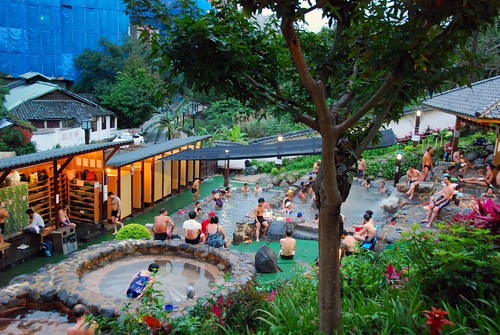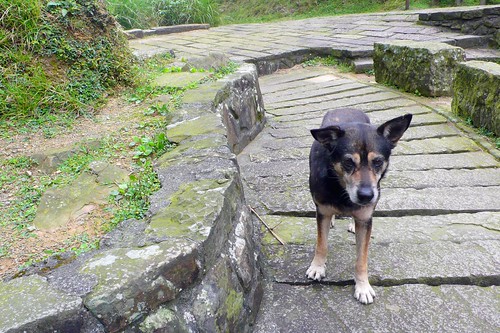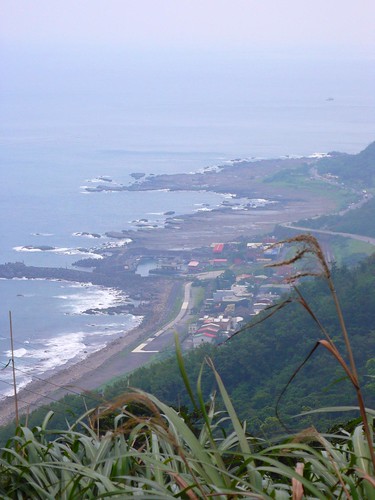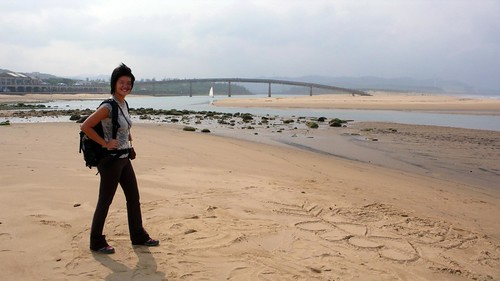Before arriving in Taiwan, I had no idea that the country was full of serious hikers. I guess I thought—like my own family—that the only hobby people from Taiwan really took seriously was eating. ![]() But it totally makes sense, this little island is blessed with a rugged coastline and a seriously mountainous interior (with several 3000m mountains!) and there are oodles of hiking trails to explore, many within day-trip distance of Taipei.
But it totally makes sense, this little island is blessed with a rugged coastline and a seriously mountainous interior (with several 3000m mountains!) and there are oodles of hiking trails to explore, many within day-trip distance of Taipei.
A few weekends back, Jeremy and I took a day trip out to the east coast of Taipei in order to hike the Cao Ling Historical Trail (căo líng gŭ dào), a 10km road (interestingly, most of the hiking trails we have encountered are actually stone-paved roads, unlike the dirt trails we have in the States) originally built in the early 1800s to provide transport from the ocean to Taipei. We started the hike in Dali and hiked to Fulong, though you could easily do it the other way around.
The train ride out there is quite beautiful…you pass through the longest tunnel in all of Asia before traveling along the rugged coastline towards Dali. This is the first time we have seen the ocean in Taiwan…weird to think that just on the other side of that blue expanse sits California (yup, Taiwan is bordered on the east side by the Pacific).
The trailhead begins right next to beautiful and elaborate Tiengong Temple (where, apparently, you can stay the night).
Early on in our hike, we acquired a four-legged friend, who stayed by our side pretty much the entire time, despite our best attempts to convince him that we weren’t going to give him any food. We even told him in two different languages!
The views of the coast were stunning as we climbed higher and higher into the mountains.
Cao Ling Historical Trail is most famous for two stone tablets that sit along the road. Both tablets were carved by an unfortunate traveler who got caught on the trail during one of Taiwan’s famous typhoons. Along the way, he carved the Chinese character for “tiger” (虎) into a rock (in Chinese mythology, the tiger is thought to control the winds), and the Tiger Tablet is now the trail’s most famous landmark.
A little while later, there is another enormous carved boulder reading, “Boldly quell the violent mists.” Poor guy, we had great weather while we were hiking, but even then it was still quite windy. I can only imagine what it must be like with a typhoon slamming into the side of the mountain!
Once you reach Fulong, you can head to the beach…there is a paid-entry area (I think it was NT$40 each, or about US$1.10), or you can walk a little further into town and access the beach for free (though the paid area is cleaner). Since we weren’t planning on hanging out at the beach for long, we just walked along the free area, but I can imagine that on a nice weekend this beach would be quite nice.
There is another really elaborate temple (I think it is Taoist? Apparently if the altar contains some fierce-looking bearded guys, then it is Taoist) on the far end of the beach in Fulong.
Taiwanese people may be serious about hiking, but there is another thing they take even more seriously (no it’s not food): hot springs! The country is full of them, and after Taiwan, I am not sure if I can face another hike if there is not a hot springs waiting for me at the end of it! From Fulong, we hopped on the train to Jiaoshi (about half an hour train ride south) to check out their public hot springs.
Jiaoshi’s public hot springs are segregated into men and women-only sections since no clothing is allowed. Entry is NT$80 each (about US$2.50), and women must wear shower caps (kind of bummer since it gets pretty hot in there).

This is actually Beitou Hot Springs (in northern Taipei), not Jiaoshi, but I thought you might like to see what a Taiwanese hot spring looks like. You can’t take photos inside Jiaoshi hot springs since everyone is, you know, naked.
A few things you should know before visiting Taiwan’s hot springs: first of all, they really put the “hot” in “hot springs.” If you dare to enter the hottest pool, be warned that the water will be scalding! You can tell by the myriad of lobster-colored Chinese men sitting around the springs.
Secondly, Taiwanese people have these funny exercises that they do in the hot springs (I think they are trying to promote blood circulation). You’ll often see these old Chinese guys doing pelvic thrusts or gyrating madly around the pools while slapping their own asses or beating themselves on the chest. It’s pretty amusing, to say the least.
Jiaoshi is also known for it’s cōng yóu bĭng (spring onion pancake). The most famous place is next door to the Jiaoshi post office; there will be a huge line out the door. Their version is deep-fried until the dough is puffy and glutinous, and you brush on your choice of three different sauces (soy, chili, and something else that tasted good) before they topped off with an egg. I don’t have a photo of this because I ate it too fast. YUM!!!
Cao Ling Historical Trail was a great outing and we recommend it if you’re ever out this way. It’s super close to Taipei (about an hour on the train) and a beautiful way to spend a nice day in Taiwan.







Ok- it has been so fun reading through your blog! I can’t believe all the experiences you’re having. Is one of the stops around the world McAllen, Texas? It’s been way too long since I’ve seen you guys! Heather